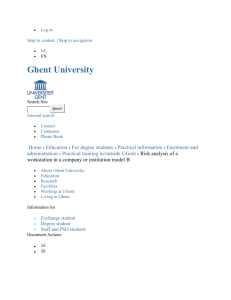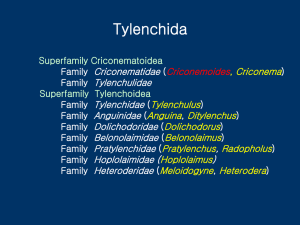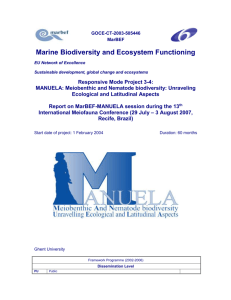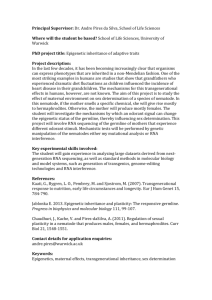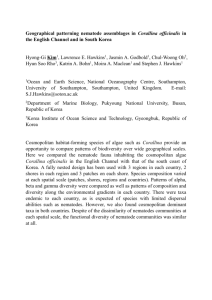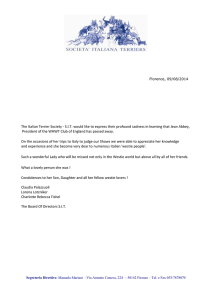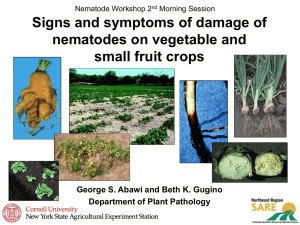Reports - MarBEF
advertisement
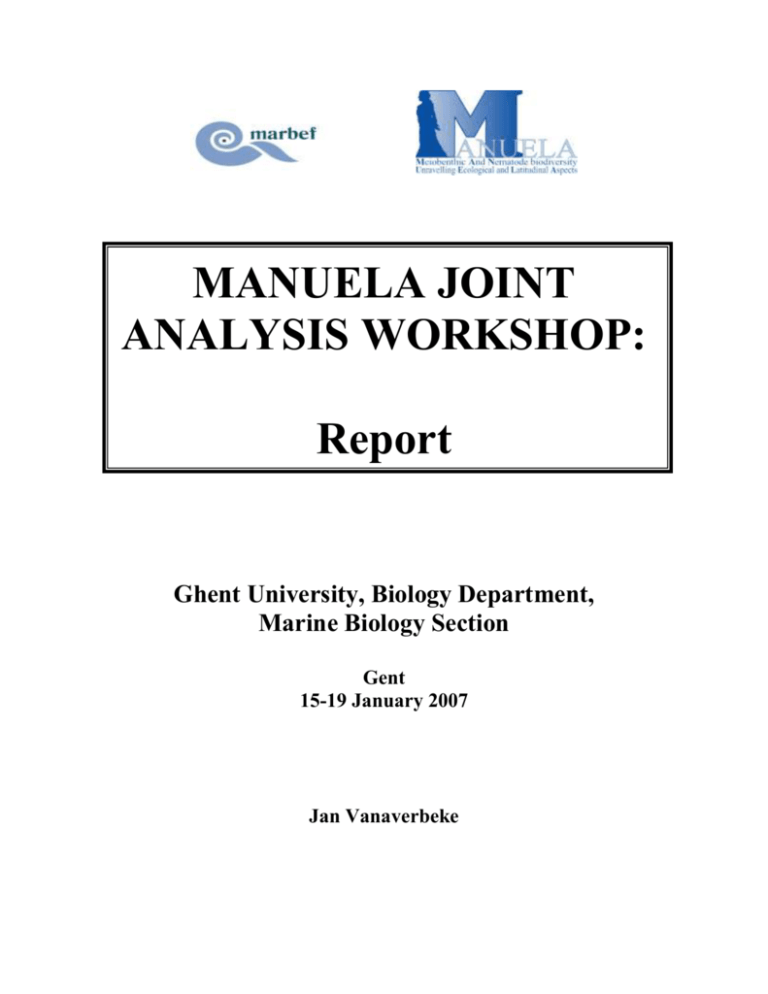
MANUELA JOINT ANALYSIS WORKSHOP: Report Ghent University, Biology Department, Marine Biology Section Gent 15-19 January 2007 Jan Vanaverbeke 1. MANUELA Joint Analysis Workshop Programme Monday 15/01 9.00: Welcome and introduction to the workshop (Jan Vanaverbeke) 9.15: The Manuela Database: history and structure (Leen Vandepitte– Ward vanden Berghe)) 10.00: Mutual Declaration of Understanding on the use of Manuela Data (Jan Vanaverbeke) COFFEE BREAK Introduction to research topics 10.30 – 10.45: Universal effects of disturbance of meiofauna communities (Michaela Schratzberger) 10.45 – 11.00: Deep-sea meiobenthos (Ann Vanreusel) 11.00 – 11.15: Large scale patterns in community composition (Maaike Steyaert) 11.15 – 11.30: Nematode biomass spectra, size and shape (Jan Vanaverbeke) 11.30 – 11.45: Species Assembly Rules (Bea Merckx)) 11.45 – 12.00: Patterns in harpacticoid copepods (Gritta Veit-Koehler) AFTERNOON: ANALYSIS Tuesday 16/01 – Wednesday 17/01: HANDS ON ANALYSIS Thursday 18/01 9.00 Further Planning of the MANUELA joint analysis (Maaike Steyaert) EVENING: Dinner in the historical centre Friday 19/01 9.00: Report of different working groups (15 minutes per working group) 2. Report Monday 15 January 2007 After a tour de table during which all participants introduced themselves and their interests, the aims of the workshop were set out by Jan Vanaverbeke. workshop was organised in order to analyse the joint MANUELA database, compiled in 2006. During the kick-off meeting (September 2006) it was decided that at least 6 topics would be investigated by means of the data compiled in the MANUELA database. These topics included: 1. Large scale patterns in meiobenthic diversity and community composition 2. Universal response of meiobenthos to disturbance 3. Patterns in biomass spectra, size and shape op marine nematodes 4. Deep-sea meiobenthos 5. species assembly rules 6. Patterns in harpacticoid copepod community composition and diversity Meanwhile, it was decided that the RMP MANUELA would organise a MarBEFMANUELA session on the forthcoming 13th International Meiofauna Conference (ThirIMCO) (29July -4 August 2007, Recife, Brazil). During this session, MarBEF and MANUELA could be introduced in a general talk. Further topics should include the presentation of NeMys as a tool for nematode identification and the presentation of the results obtained from the analysis of the MANUELA database. Leen Vandepitte introduced the MANUELA database. This database consists of 73 component datasets, submitted by 12 institutes. Data originated from 1380 stations and 5052 samples. The number of counts included in the database was 123307, mainly on nematodes. 12060 species records were submitted on 1746 taxa. The majority of the component datasets resulted from field studies; however 10 experimental datasets were submitted as well. Abiotic information was available in 43 datasets and biometric information on nematodes (length, width or biomass) was incorporated in 9 component datasets. Edward vanden Berghe showed the structure of the database and revealed tips and tricks on how to work with the database. VLIZ built special tools to simplify query building, export files to Primer, and calculate a variety of indices. All these tools were demonstrated. Jan Vanaverbeke reminded on the fact that the use of the database was subjected to the Declaration to Mutual Understanding on Data Sharing. Michaela Schratzberger introduced the research topic on the universal response of meiobenthos to disturbance. The existence of such a universal response is investigated within MANUELA through two approaches. In spring 2007, possible changes in meiobenthic community patterns will be investigated experimentally on a European scale. The second approach involves a meta- analysis of available data in the MANUELA database. During such an analysis, both the response and resilience of the communities towards changes in ecosystem processes and disturbances can be investigated. After a review of the available literature, three hypotheses were formulated: H0: Communities of the same broad group of animals (meiofauna) do not respond in a differential way to different types of disturbance (i.e. there is simply a generalised stress response) H0: Meiofauna does not respond in a differential way to different frequencies of disturbance (Intermediate Disturbance Hypothesis etc.) H0: The nature of the disturbance response does not differ according to the environmental conditions that the assemblage normally experiences (i.e. the response is independent of the type of receiving assemblage) These hypotheses can be tested using a subset of the MANUELA dataset, including field surveys along disturbance gradients and/or experimental work at various spatial scales The topic on deep-sea meiobenthos was introduced by Ann Vanreusel A literature review revealed that there is an increase in the proportion of rare genera in nematode communities when bathymetric depth increases Moreover, nematode communities seems to be dominated by the same genera at similar depths independent of their geographical location On the other hand, there is a shift in dominant genera with depth When different environments (reduced environments in the vicinity of mud volcanoes) or substrates (dead corals, sponges, soft sediments) were taken into account, it became clear that the composition of nematode communities is closely associated with the prevailing environmental conditions The general research idea within this topic was to investigate whether nematode genus composition in the deep sea can be predicted based on food, substrate and biochemical conditions. Maaike Steyaert gave a talk on the third topic: large-scale pattern in marine nematode communities. Since quite a lot of data are available in the database, different questions can be addressed; • Can we discriminate different assemblages based on environmental/geographical factors (e.g. region, depth, sediment type) • What taxonomic level is needed to discriminate these patterns in our dataset • What factor is most important to discriminate the assemblages • Is there a gradual change in assemblages according to the different factors Possible approaches involve the use of second stage MDS to compare the patterns obtained on different taxonomic levels (e.g. species, genus, family…). However, in a first step, focus should be on deriving a correct partial dataset from the main MANUELA database. Further emphasis should then be on identifying the most important factor structuring the nematode assemblages on a large scale (e.g. depth, sediment type…). During the workshop, this topic was lead by Maaike Steyaert, but in the near future this will be done by Paul Somerfield. Jan Vanaverbeke continued with a presentation on the planned work on nematode biomass spectra and size and shape of nematodes. Nematode biomass spectra seem to be a promising tool to describe changes in the ecosystem (natural occurring events or human induced disturbance), but a straightforward mathematical description of these spectra was not published so far, and hence a relatively elegant method for comparing nematode biomass spectra is not available so for. Therefore a first aim of this topic is to find a method for describing and comparing nematode biomass spectra. A second subtopic involves research on the size and shape of nematodes. Earlier publications, limited in time and space revealed the existence of different morphotypes within the nematodes. The MANUELA database holds the majority of the European datasets in which nematode biometrics was investigated and therefore offers a unique opportunity to explore the generality of these findings The topic on species assembly rules was presented by Bea Merckx. The understanding of species assembly rules is important to understand the factors enabling high diverse communities to co-exist and to estimate the relative importance of biological processes versus abiotic factors and stochastic processes in structuring communities. In a first step, this will be done using only a part of the MANUELA database for which many environmental data are available (eg. Belgian Continental Shelf). In a late scale, results will be upscaled using the MANUELA database. At the same time, nematode communities will be modeled using neural network approaches. Gritta Veit-Köhler brought forward possible research topics on harpacticoid copepods. Although only a limited amount of data is available in the MANUELA database, the origin of the data is widespread over Europe and even over the globe. The analysis on the copepod part of the database should focus on the relation between diversity and density and diversity-related rarity. In a first step, focus should be on the alpha diversity, being the diversity within a core or a small area, comparing diversity at core scale across areas and a comparison of this alpha diversity at station/dataset level. In the afternoon, participants split up in different groups according to the research topics. Analysis went on until Thursday evening. On Thursday morning, some of the participants gathered separately to discuss the further planning of the MANUELA joint experiments. This discussion was chaired by Maaike Steyaert. Friday 19 January 2007 On Friday morning, the preliminary results of the different working groups were reported to all participants. Jan Vanaverbeke started with a contribution on the nematode biomass spectra and nematode size and shape. Nematode biomass spectra were constructed for all datasets were biometric information was available. Biomass spectra were normalised and a regression line was constructed. Individuals belonging to the lowest size classes were omitted from the regression. In most cases, a significant regression was found and the slope of the regression was used to compare the different areas. In general, the slope was not affected by depth. In contrast, slope differences were obvious between areas or seasons within an area. The analysis of the nematode size and shape patterns confirmed the general presence of two morphotypes. In addition, a third morphotype was observed in very reduced sediments. In general, there seems to be a linear trend between nematode length and width when taking into account all data, only nematodes from the Aegean Sea have an aberrant length/width ratio. In addition, maximum diversity within a station seems to be coupled with an ideal length, width and length/width ratio. Tim Deprez gave an overview of the results obtained by the large-scale patterns group. From the beginning it became clear that analyzing this amount of data is requiring quite some commuter time and is therefore a time-consuming activity. However, a first analysis using all species information available revealed the existence of depth related patterns and the difference in nematode species composition in different geographical areas. Further 2nd stage MDS analysis, restricted to beach nematode communities revealed the difference between the analysis conducted at species level and higher taxonomical levels. The results of the disturbance study were presented by Michaela Schratzberger. This working group limited the amount of data to 4 datasets from field surveys and 7 experimental datasets. A first analysis revealed that nematode communities can be distinguished based on sediment type but not by study approach (field versus experiment) and location. A subsequent analysis showed that disturbed nematode communities from different locations have more similar communities than the non-disturbed communities from the same locations. These results will be at the basis of future analyses in which the communities will be explored in terms of: genus composition and diversity trophic structure size composition (based on taxonomic literature) taxonomic (and functional) relatedness response across man-made activities (2nd stage MDS) relationship to environmental variables (local disturbance regime) comparison with results from experimental studies Ann Vanreusel showed the results obtained by the working group on deep-sea nematodes. In a first step, spatial patterns in deep-sea diversity were investigated. Initial results showed that genus diversity did not decrease towards a depth of 2000 m, deeper stations showed lower genus diversity. However, patterns were different between regions. There were no clear patterns related with latitude, in general the Atlantic Ocean seemed to be the most diverse, but highest variability was observed here as well. An analysis on spatial patterns on nematode community composition clearly showed a bathymetric zonation: upper slope communities were distinguished from deeper areas and some typical genera for each depth zone were identified. Within each bathymetric zone, there were differences between oligotrophic and eutrophic deep-sea nematode communities, here again typical genera were associated with areas with a contrasting productivity regime. A final analysis on the spatial patterns of dominant genera confirmed the patterns already observed in literature. Gritta Veit-Köhler was responsible for the final presentation on the harpacticoid copepods. This analysis was based on a limited amount of datasets. Therefore there was a call to add data on copepods to the MANUELA database. The lists of possible extra datasets have to be communicated to Leen Vandepitte by 26th January. Deadlines for submission will then be communicated by VLIZ. Multivariate analysis revealed significant differences between geographic areas, which was reflected in the various diversity analysis calculated. These analyses will be at the basis for future work on harpacticoid copepods within MANUELA. Finally, it was concluded by all participants that this workshop was successful and yielded promising results. It was agreed that these results would be communicated at the 13th Meiofauna Conference during a MarBEF-MANUELA session. Communication with the local organizers will be done by Jan Vanaverbeke. All participants very warmly acknowledge and appreciate the work done by VLIZ – Leen Vandepitte and Ward vanden Berghe – to create the largest database on meiobenthos worldwide. Their effort will result in a series of papers which will be very significant for future meiobenthic research. 3. List of Participants Name Helena Adao Tim Deprez Marleen De Troch Cristina Gambi Mateja Grego Nikolaos Lampadariou Bea Merckx Michaela Schratzberger Karline Soetaert Maaike Steyaert Basia Urban-Malinga Jan Vanaverbeke Edward Vanden Berghe Institute University of Evora (Portugal) Ghent University (Belgium) Ghent University (Belgium) Polytechnic University of Marche (Italy) National Institute of Biology (Slovenia) HCMR (Greece) Ghent University (Belgium) CEFAS (UK) NIOO-CEME (The Netherlands) Ghent University (Belgium) Sea Fisheries Institute (Poland) Ghent University (Belgium) VLIZ (Belgium) Email address hadao@uevora.pt Tim.Deprez@UGent.be Marleen.Detroch@UGent.be c.gambi@univpm.it Mateja.Grego@mbss.org nlamp@her.hcmr.gr Bea.Merckx@UGent.be M.Schratzberger@cefas.co.uk K.Soetaert@nioo.knaw.nl Maaike.Steyaert@UGent.be basiam@iopan.gda.p Jan.Vanaverbeke@UGent.be wardvdb@vliz.be Leen Vandepitte Saskia VanGaever Ann Vanreusel Gritta Veit-Koehler Magda Vincx VLIZ (Belgium) Ghent University (Belgium) Ghent University (Belgium) DZMB (Germany) Ghent University (Belgium) leen.vandepitte@vliz.be Saskia.VanGaever@UGent.be Ann.Vanreusel@UGent.be gveitkoehler@senckenberg.de Magda.Vincx@UGent.be
